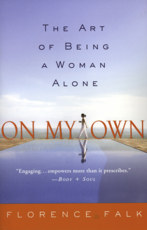 Excerpt
from On My Own: The Art of Being a Woman Alone
Excerpt
from On My Own: The Art of Being a Woman Alone
by Florence Falk
In my work as a psychotherapist, I have seen a succession of women trying to reclaim the self. They come seeking relief from the pain of something that has gone awry in their lives, which could be anything from breaking up with a boyfriend to marriage wounds to a hypercritical boss to some undefined but persistent angst. But as soon as that pain has abated just a little, and they begin to listen to their inner feelings, they discover that they are far more severe on themselves than anything the outside world has to offer. That's when they begin to get in touch with the fears that have been holding the self in thralldom.
Yet, sooner or later, the self will appear. It has gone into hiding because it was too raw and vulnerable to survive otherwise, or, in writer Peggy Orenstein's words, because it has experienced "things too tender to tell." For to whom does a woman tell her painful truths when she feels unseen? To feel invisible is to believe that we are without worth, and nothing sends the self into hiding faster. Such loss of self often reveals itself in a woman's dreams. A woman whose energy is blocked might, for example, dream of herself as a large mammal -- a stallion brought to its knees; an ape trapped behind bars; a caged panther endlessly circling; a white porpoise lashed to a ship's mast, desperately trying to breathe out of its element. A woman suffering neglect might be more likely to conjure up images of smaller abandoned creatures -- a starving kitten or puppy or an infant alone in her carriage, forgotten. Or the identity of a self might be splayed, as in one patient's dream of a half-human, half-fishlike creature that slipped out of her mother's body. But as we begin to get in touch with these feelings and acknowledge the "tender things" we carry inside, little by little the self dares to show itself. The stallion gallops, the ape is uncaged, the panther sprints, the porpoise swims in its natural element; these creatures are, after all, descriptions of energy that is now free to help the self assume its true dimensions.
Self-Blessing
There is still a missing piece we need to set in place before we are ready to step out. This is the blessing that consecrates the self and sets it in motion, and which the poet Galway Kinnell has written about in "Saint Francis and the Sow" with deep, heartfelt wisdom: "The bud/stands for all things,/even for those things that don't flower,/for everything flowers, from within, of self-blessing." The word blessing is one of the richest, most confluent in our language. From its English roots, blessing carries the meaning of consecration and holiness, but also of the mark of blood. From French, the verb blesser -- to wound -- bespeaks the blood wound that makes every blessing sacred and holy. A blessing, then, is an act of reverence that bestows protection, holiness, and love on the benefactor. But Kinnell is also saying that the deepest blessing is the one you bestow upon yourself.
Sometimes, as Kinnell also reminds us, our capacity for self-blessing must be awakened from without: for "sometimes it is necessary to reteach a thing its loveliness, put a hand on the brow of the flower and retell it in words and in touch it is lovely." The "hand on the brow" is the offering of one human being toward another. It may come from parental or companionate love, the compassionate caring of a minister toward her flock or of a therapist toward her patient, or the healing energy of certain family members, friends, or communities. What matters above all is that the touch of this hand be as full of affirmation as it is free of self-interest. Then it can help the woman to gather her own strength so that she does not have to lean on another.
Blessing is also an initiation. The path of a woman's journey reaches, after all, far beyond her passage from girlhood to womanhood, which means that we will need not one, but many, ritual markers to help us find our way from one life-crossing to the next. Each threshold, each divide between crossings, marks a real moment in time. It also has profound mythic and symbolic content. Both need to be recognized.
Think of all the markers in your own life when something happened to change you, when you realized in a simple but defined way that you were different than before. Think of the blessing you gave yourself -- or received from others. Or did not. And know that it is never too late.
Copyright © 2007 Florence Falk
